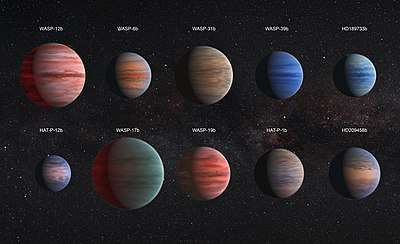HAT-P-1b
HAT-P-1b is an extrasolar planet orbiting the Sun-like star HAT-P-1, also known as ADS 16402 B. HAT-P-1 is the dimmer component of the ADS 16402 binary star system. It is located roughly 521 light years away from Earth in the constellation Lacerta. HAT-P-1b is among the least dense of any of the known extrasolar planets.
 Size comparison of HAT-P-1b with Jupiter. | |
| Discovery | |
|---|---|
| Discovered by | HATNet Project[1] |
| Discovery site | Arizona and Hawaii[1] |
| Discovery date | Thurs, Sept 14, 2006[2] |
| Transit, radial velocity[1] | |
| Orbital characteristics | |
| 0.05561 ± 0.00083 AU (8,319,000 ± 124,000 km)[3] | |
| Eccentricity | <0.067[4] |
| 4.4652968 ± 0.0000018[5] d | |
| Inclination | 85.634 ± 0.056[3] |
| Semi-amplitude | 59.3 ± 1.4[4] |
| Star | HAT-P-1 (ADS 16402 B) |
| Physical characteristics | |
Mean radius | 1.319 ± 0.019[3] RJ |
| Mass | 0.529 ± 0.020[5] MJ |
| Temperature | 1322 ± 15[3] K |
Discovery
HAT-P-1b was detected by searching for astronomical transits of the parent star by orbiting planets. As the planet passes in front of its parent star (as seen from Earth), it blocks a small amount of the light reaching us from the star. HAT-P-1b was first detected by a dip of 0.6% in the light from the star. This enabled determination of the planet's radius and orbital period. The discovery was made by the HATNet Project (Hungarian Automated Telescope Network) using telescopes at the Fred Lawrence Whipple Observatory on Mount Hopkins in Arizona and at the Submillimeter Array facility in Hawaii. It was confirmed and the orbital parameters determined by radial velocity measurements made at the 8.2 m Subaru and 10 m Keck telescopes, the discovery announcement being made on September 14, 2006.[2][1]
Orbit and mass
HAT-P-1b is located in a very close orbit to its star, taking only 4.47 days to complete.[1] It therefore falls into the category of hot Jupiters. At only 8.27 million kilometers from the star, tidal forces would circularise the orbit unless another perturbing body exists in the system. At the present time, the existing measurements are not sufficient to determine the orbital eccentricity, so a perfectly circular orbit has been assumed by the discoverers.[6] However, the eccentricity of the planet was calculated to be no greater than 0.067.
In order to determine the mass of the planet, measurements of the star's radial velocity variations were made by the N2K Consortium. This was done by observing the Doppler shift in the star's spectrum. Combined with the known inclination of the orbit as determined by the transit observations, this revealed the mass of the planet to be 0.53±0.04 times that of Jupiter.[1]
Rotation
As of August 2008, the most recent calculation of HAT-P-1b's Rossiter–McLaughlin effect and so spin-orbit angle was 3.7±2.1°.[7]
Characteristics
As evidenced by its high mass and planetary radius, HAT-P-1b is a gas giant, most likely composed primarily of hydrogen and helium. The planet would thus have no well-defined surface. Current theories predict that such planets formed in the outer regions of their solar systems and migrated inwards to their present orbits.
HAT-P-1b is significantly larger than predicted by theoretical models.[2] This may indicate the presence of an additional source of heat within the planet. One possible candidate is tidal heating from an eccentric orbit, a possibility which has not been ruled out from the available measurements.[8] However, another planet with a significantly inflated radius, HD 209458 b, is in a circular orbit.
An alternative possibility is that the planet has a high axial tilt, like Uranus in the Solar System. The problem with this explanation is that it is thought to be quite difficult to get a planet into this configuration, so having two such planets among the set of known transiting planets is problematic.
References
- Bakos, G. Á.; et al. (2007). "HAT-P-1b: A Large-Radius, Low-Density Exoplanet Transiting One Member of a Stellar Binary". The Astrophysical Journal. 656 (1): 552–559. arXiv:astro-ph/0609369. Bibcode:2007ApJ...656..552B. doi:10.1086/509874.
- Aguilar, David A.; Pulliam, Christine (September 14, 2006). "Strange New Planet Baffles Astronomers" (Press release). Cambridge, Massachusetts: Harvard–Smithsonian Center for Astrophysics. Retrieved November 18, 2016.
- Nikolov, N.; et al. (2014). "Hubble Space Telescope hot Jupiter transmission spectral survey: a detection of Na and strong optical absorption in HAT-P-1b". Monthly Notices of the Royal Astronomical Society. 437 (1): 46–66. arXiv:1310.0083. Bibcode:2014MNRAS.437...46N. doi:10.1093/mnras/stt1859.
- Johnson, John Asher; et al. (2008). "Measurement of the Spin-Orbit Angle of Exoplanet HAT-P-1b". The Astrophysical Journal. 686 (1): 649–657. arXiv:0806.1734. Bibcode:2008ApJ...686..649J. doi:10.1086/591078.
- Turner, Jake D.; et al. (2016). "Ground-based near-UV observations of 15 transiting exoplanets: constraints on their atmospheres and no evidence for asymmetrical transits". Monthly Notices of the Royal Astronomical Society. 459 (1): 789–819. arXiv:1603.02587. Bibcode:2016MNRAS.459..789T. doi:10.1093/mnras/stw574.
- "A HAT trick". Retrieved 2007-10-14.
- Obliquities of Hot Jupiter host stars: Evidence for tidal interactions and primordial misalignments, 2012, arXiv:1206.6105
- Jackson, Brian; Richard Greenberg; Rory Barnes (2008). "Tidal Heating of Extra-Solar Planets". Astrophysical Journal. 681 (2): 1631. arXiv:0803.0026. Bibcode:2008ApJ...681.1631J. doi:10.1086/587641.
